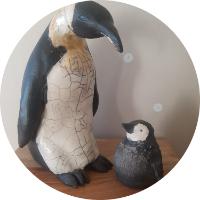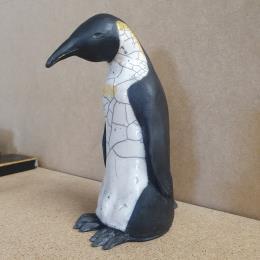
Raku Sculptures
Buying Raku Art Sculptures from Carré d'artistes in the US
Considering buying a raku sculpture?
Raku art sculptures fascinate with their mystic aura and unique aesthetic. In contemporary art, these pieces are gaining increasing interest, captivating art lovers worldwide. Discover these unique artistic treasures and delve into the dazzling world of contemporary raku sculptures.
Read more
The art of raku
Traditional raku sculpture involves the firing of ancestral clay derived from ancient Asia, particularly Japanese culture.
This method of working with materials originated in Japan and Korea and is associated with the tea ceremony. In the late 1960s, Western ceramic artisans deepened their knowledge of the rich techniques of ceramic firing.
The technique of raku
But what is raku? By definition, it’s a firing technique used by potters in Japan, that imparts unique beauty and texture to ceramics. This art is a ritual known for centuries, closely related to the philosophical approach of Zen.
In the past, artisans traditionally glazed and fired their vessels before being able to use them together to enjoy tea and let their imaginations run wild. Nowadays, this ceramic technique is primarily chosen to create pottery pieces ranging from small bowls to abstract sculptures, as well as complex forms of vases or basins.

Creating raku pottery
Creating raku pieces involves six main steps. First, the artist shapes the object using a potter's wheel. To ensure that the material is resistant to impacts and thermal variations, he may add sand, grog, and crushed clay. The clay object must then dry, which can take several days or even weeks, depending on its size and weight.
The artist then performs the first firing of their artwork, as air drying alone doesn't remove all the moisture from the clay. The first raku firing or biscuit firing truly dries the clay piece, at a temperature between 1470°F and 1560°F. The temperature gradient must be gentle to avoid thermal shock with the material.
Once the artwork is fired, the artist can begin the glazing process. The entire object is coated either by uniform dipping or precise brushwork, in one or several layers. The base glaze consists of materials used in classical ceramics, such as red lead, white lead, kaolin, silica, and borax, and can also be colored. The glaze begins to melt between 1500°F and 1800°F.
Raku firing, characterized by temperature variations and smoke effects, offers a striking blend of textures and colors, giving each statue a unique personality.
Each type of raku glaze has specific characteristics and firing temperatures, with the firing time typically ranging from 1 to 2 hours. Once the glaze reaches the desired temperature, the sculpture is placed in the kiln between 1470°F and 1650°F. Using large metal tongs, the clay pieces are then smoked in straw inside a closed container. The type of fuel used, whether coarse or fine, fresh or dry, or moist, impact the final result.
Finally, the artisan cleans the smoked raku sculpture meticulously, removing any particles and carbon deposits.
In Western-style raku, pottery is usually removed from the kiln at bright red heat and placed into containers with combustible materials. When the materials ignite, the containers are sealed, creating an intense reduction atmosphere that affects the color of the glazes and clay bodies. The drastic thermal shock also causes deliberate cracking, creating these recognizable shapes.
Contemporary Raku Sculptures: a dialogue between heritage and innovation
Contemporary raku is the bold and captivating artistic expression of a ceramist who masters ancestral techniques to create unique works of art. Raku sculptures, especially those depicting feminine beauty, come to life through this magical fusion of traditional firing and contemporary creativity.
But is raku pottery valuable? Each piece results from meticulous processes, where the ceramist plays with fire, chance, and expertise to give birth to contemporary sculptures that evoke deep emotions.
In this spirit, ceramists exploring contemporary raku push the boundaries of artistic expression, creating works that defy conventions and captivate the gaze. More than just a firing technique; it is a visual language that transcends time and creates a connection between the past and the present.
Discover a wide choice of rake sculptures for sale on our website or in our galleries around the world!
SCULPTURES BY TECHNIQUE
Sculptures By STYLE

























2.jpg)

